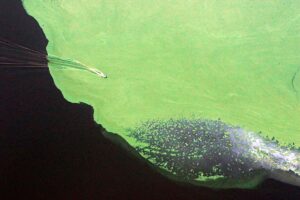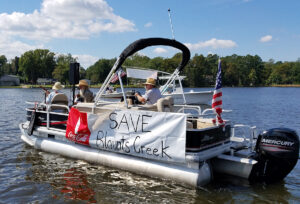News


The greater than normal rainfall this year, coupled with extreme heat, is leading to poor water quality conditions in both the Neuse and Pamlico Rivers and main tributaries. A fish kill has been reported in Blounts Bay, Beaufort County on July 18th and Bath Creek is suffering from a extensive algal bloom (yes, that is why it looks green!). Additionally, two large fish kills have already occurred on the Neuse River.
We expect that, if the heat and rain continues, we’ll likely see more algal blooms and fish kills. Algae in our rivers is a very normal thing. The Neuse and Tar-Pamlico Rivers host a wide array of different types of algae. But during certain conditions (heat, nutrients and calm waters) algae will multiply (bloom) causing waters to be discolored and even at times green or blue (from the algae known as blue-greens). Not all algae blooms are toxic, but since water testing is irregular, we recommend that people avoid primary contact with waters where an algal bloom is present.
Swimming in the Neuse and Tar-Pamlico; Is it Safe?
The information we have currently leads us to believe that it is safe to swim in the rivers the majority of the time. There are definitely instances, however, when one should not risk swimming in the river or its creeks (see list below). The river does suffer from nutrient pollution that at times leads to algal blooms and fish kills. During such events, it is strongly advised that contact with the water be avoided. It is rare, but there are times in the Pamlico and Neuse Rivers when a harmful algal bloom (HAB) has been present. A HAB may release a toxin that could impair your health; children and pets are the most susceptible.
Bact erial contamination is typically our top concern regarding public health and safety while swimming or engaging in other recreation that leads to contact with the water. There are locations that are more likely to have bacterial contamination issues, especially during and after rain storms. The state does sample common swimming areas. However, urban areas have numerous pipes that drain the streets, parking lots, business, etc. It is a well known fact, including in the harbor area of Washington, that after a rain storm the bacteria content increases. Sewer spills are most likely to occur during heavy rains. If a sewer spill does occur, utility officials are required to notify the public.
erial contamination is typically our top concern regarding public health and safety while swimming or engaging in other recreation that leads to contact with the water. There are locations that are more likely to have bacterial contamination issues, especially during and after rain storms. The state does sample common swimming areas. However, urban areas have numerous pipes that drain the streets, parking lots, business, etc. It is a well known fact, including in the harbor area of Washington, that after a rain storm the bacteria content increases. Sewer spills are most likely to occur during heavy rains. If a sewer spill does occur, utility officials are required to notify the public.
Recommendations for when to skip the water and wait for another day:
- You notice an active fish kill, or remnants of fish kill; Report Fish Kills
- An Algal bloom that is visible (water looks green), or an advisory has been issued about an algal bloom;
- Swimming advisories are issued by the state or local government;
- You have an open wound. Best to wait until it heals;
- A significant rain storm after periods of dry weather, for first 2-3 days;
- Flooding or high water. Heavy rains and flooding can typically lead to sewer overflows and urban areas are especially susceptible to this. (Not to mention high flows are really dangerous!)
- If you come into contact with an algal bloom, wash thoroughly. Do the same for your pets with clean water.
- If your child or family member appears ill after being in waters with an algal bloom, seek medical care immediately.
- If your pet appears to stumble, stagger or collapse after being in natural waterbodies, seek veterinary care immediately.
As always, use common sense when coming in contact with the water. If it doesn’t look or smell right, then play it safe.
Related News

NCDEQ issues Blounts Creek permit, again
December 18th 2025

Kinston Clean Creeks wraps up with Adkin Branch adventure
December 18th 2025

Water Watchers meetup a Zoom success
December 18th 2025

Greenville trash trap sheds 17 pounds
December 18th 2025

Specialist wraps up project tracking pollution on urban waterway
December 10th 2025

Summer intern needed — apply here!
December 8th 2025

Kingsboro data center concerns spark big turnout
December 4th 2025

Specialist tracking down sites for yearlong Slocum sampling
December 4th 2025

